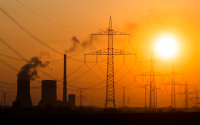28 February 2005Scott StreatersFort Worth Star-Telegram / Environmental News Network
Texas lawmakers are joining clean-energy advocates in an effort to dramatically expand the use of wind and solar power and other renewable energy sources across the state.Texas, the nation's largest electricity consumer, has one of the best renewable energy programs in the country, but some lawmakers and advocates say the state has yet to fully tap those resources. The resulting savings could dramatically cut electricity bills and power plant pollution.State Sen. Troy Fraser, R-Horseshoe Bay, has introduced a bill in the Legislature that would require 10 percent of the state's electricity to come from renewable energy sources by 2025.The state now mandates that about 2.7 percent be derived from renewable sources by 2009."Long-term, this is good public policy for the state," Fraser said. "This is a good hedge against fossil fuels and our dependence on foreign oil."A coalition of clean-energy advocates and environmentalists is pushing a stronger proposal. It would require by 2020 that 20 percent of the state's energy production be derived from renewable energy -- a whopping 17,820 megawatts, or enough electricity to power 4.9 million homes. The 20 percent proposal does not have a legislative sponsor.But any expansion of renewable energy will require building miles of transmission lines to carry the electricity produced by wind turbines to urban areas.The state estimates that it will cost $1 billion to build transmission lines to support an additional 5,000 megawatts of wind power. The money to pay for those transmission lines would probably come from fees based on electricity usage, officials say, meaning industry would be hit hardest."I don't want to give the impression that we're not willing to work on the issue, but transmission to get wind power from West Texas and other remote areas of the state to market can be very expensive," said Phillip Oldham, chief counsel for the Texas Coalition for Competitive Electricity, which represents large commercial and industrial consumers."To the extent that renewable energy is cost-competitive and beneficial to the state, we have no issue with it being incorporated and think it serves a valuable purpose," he said. "To the extent that the infrastructure costs outweigh the benefit of it, then we have concerns."Renewable energy proponents agree that transmission capacity must be improved. But Tom "Smitty" Smith, a member of the Texas Renewable Energy Industries Association, the clean-energy group pushing the 20 percent proposal, said the cost has been exaggerated.Smith, also director of the Texas chapter of Public Citizen, said the cost would be spread over decades and would add no more than $1.06 to the average monthly residential electricity bill.The Union of Concerned Scientists, a 100,000-member partnership of scientists and citizens, conducted a detailed study of both proposals at the request of the coalition. The 34-page analysis, released this month, concluded that both proposals would slash residential and industrial energy bills by at least $5.5 billion in the next two decades, as well as create thousands of permanent jobs."But the 20 percent standard would actually provide significantly greater economic development and environmental benefits," said Jeff Deyette, an energy analyst with the group.The union estimates that 38,290 jobs would be created by the 20 percent proposal. It would also slash an estimated 34,000 tons of smog-forming pollutants a year by curtailing coal-fired power plant production, Deyette said.Fraser said the state needs to proceed cautiously to make sure wind power, in particular, can handle the job. For instance, Texas' peak electricity demand occurs in July, August and September, when the state's winds decline sharply."We need to be somewhat deliberate as we go forward in making sure that there's a balance," Fraser said. "That balance is more than putting in the wind turbines, it's having the transmission to transmit it, and then having a backup source for reliability."Texas is already a national leader in renewable energy. In June 1999, the Legislature adopted one of the nation's first, and at the time largest, renewable energy programs."I think it's fair to say that Texas was viewed as a pioneer," said Stephen Wieland, business development manager for Vestas, a Danish wind turbine manufacturer.Texas set a national record in 2001 by installing more wind power capacity in a single year than any state in any previous year. Much of the buildup took place at the King Mountain Ranch "wind farm" in McCamey, about 75 miles south of Midland. It is the world's largest wind power project today.But in the past several years, 15 states have surpassed Texas' program. New York, California and Hawaii have enacted requirements that at least 20 percent of energy companies' output be from renewable sources by 2020. Source: Knight Ridder/Tribune Business News






